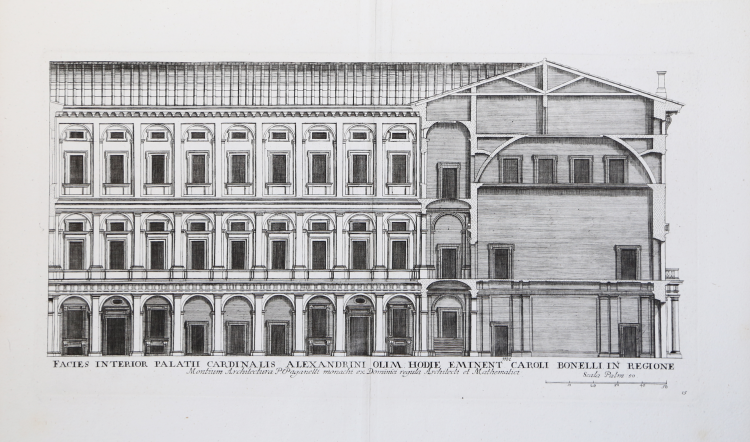



| Reference: | s25744 |
| Author | Joachim von SANDRART |
| Year: | 1675 ca. |
| Zone: | Palazzo Valentini |
| Printed: | Nurnberg |
| Measures: | 420 x 220 mm |


| Reference: | s25744 |
| Author | Joachim von SANDRART |
| Year: | 1675 ca. |
| Zone: | Palazzo Valentini |
| Printed: | Nurnberg |
| Measures: | 420 x 220 mm |
Plate taken fom the monumental Academia Todesca della Architectura, Scultura & Pittura: oder Teutsche Academie der Edlen Bau, Bild-und Mahlerey-Künste (Deutsche Academy of Architecture - Sculpture – Painting).
Sandrart's work are inspired by the series Palazzi di Roma […] by Pietro Ferrerio.
This series of etchings is divided into two books showing the plans and architecture of various buildings in Rome. The two books were published in Rome by Gian Giacomo de Rossi, in 1655 circa. The first volume, titled Palazzi di Roma de' più celebri architetti designati da Pietro Ferrerio pittore et architetto, contains 44 etching, all except one identifying Pietro Ferrerio as draftsman. The second book, Nuovi disegni dell'architettura e piante de'palazzi de Roma de'piu celebri architetti, disegnati et intagliati da Gio. Battista Falda, contains 61 etchings by Giovanni Battista Falda.
The first edition, in German, was published by Joachim von Sandrart in Nuremberg, in three volumes respectively in 1675, 1679 and 1680.
For the plates Sandrart used his students as and many others artist as Karl Gustav von Amling (1650-1703); Philip Kilian (1628-1693); Richard Collin (1627-97); Georg Andreas Wolfgang (1631-1716); Johann Georg Waldreich (d.1680); Melchior Küsel (1626-1683); Franck, Johann (fl.1659-1690); George Christoph Eimmart (1638-1705); Susanna Maria von Sandrart (1658-1716); Bartholomäus Kilian (1630-1696).
The work is full of illustrations of ancient and modern Roman buildings, sculpture, the theory of painting, biographies of artists, including German and contemporary (ie seventeenth-century) artists, and antiquities.
Joachim von Sandrart was a painter of some note but it is for his Teutsche Academie that he is chiefly remembered. His compendious treatise includes sections on ancient sculpture and architecture, perspective, the theory of painting, artists’ biographies, a translation of Ovid’s Metamorphoses and so on. The second part of Book I purports to give a history of art from its earliest origins, and opens with an engraving of two scenes of legendary accounts of the discovery of drawing.
The frontispiece to Volume I is signed as drawn by J. de Sandrart and engraved by C.G. Amling; that of Volume II is signed as drawn by Sandrart and engraved by R. Collin. The portrait in Volume I is signed as painted by J.U. Mair and engraved by P. Kilian; that in Volume II is signed as engraved by R. Collin. Many plates are signed as drawn by Sandrart and engraved by R. Collin or other engravers (J. Franck, G.A. Wolfgang, J.G. Waldreich, I.I. Thourneyser, Melchior Küsell, G. C. Eimmart, B. Kilian, Jacob Sandrart, Joh. Meyer, Susanna von Sandrart, J.A. Boener, C. Meyer). Many plates are unsigned.
The work is dedicated to the world-renowned German nation and to champions and lovers of art ('Der Welt-berühmten Teutschen Nation ... Kunst-Helden und Kunstliebenden').
Etching with margins, very good condition.
References
National Gallery (Washington), Mark J. Millard, III (1998), no. 111; F.W. H. Hollstein, German engravings ... ca. 1400-1700 (1954-), 38-41; Anna Schreurs, Unter Minerva schutz: bildung durch kunst in Joachim von Sandrarts 'Teutscher Academie' (2012).
Joachim von SANDRART (Francoforte 1606 - Norimberga 1688)
|
German painter and treatises. Traveled extensively and was the most important German artist of the time but is remembered today almost exclusively for the "Teutsche Academie der Edlen Bau-Bild-und Mahlerey Künste" (German Academy of the noble arts of architecture, sculpture and painting) , published in Nuremberg in 1675-79 and followed by Latin edition in 1683. This treaty, organized into three main sections, is a source of great importance. The first part is an introduction to the art of architecture, painting and sculpture, mainly derived from earlier sources like Vasari and Van Mander. The second part, which contains biographies of artists, uses the same way as material from earlier sources, but also contains new material, especially on German artists and contemporary artists that the author knew personally (including Poussin and Lorrain). The third part contains information on art collections and a survey 'iconography, and finally there is also a chapter on the art of the Far East. Sandrart was the first director (1662) Academy of Nuremberg (the first in Germany).
|
Joachim von SANDRART (Francoforte 1606 - Norimberga 1688)
|
German painter and treatises. Traveled extensively and was the most important German artist of the time but is remembered today almost exclusively for the "Teutsche Academie der Edlen Bau-Bild-und Mahlerey Künste" (German Academy of the noble arts of architecture, sculpture and painting) , published in Nuremberg in 1675-79 and followed by Latin edition in 1683. This treaty, organized into three main sections, is a source of great importance. The first part is an introduction to the art of architecture, painting and sculpture, mainly derived from earlier sources like Vasari and Van Mander. The second part, which contains biographies of artists, uses the same way as material from earlier sources, but also contains new material, especially on German artists and contemporary artists that the author knew personally (including Poussin and Lorrain). The third part contains information on art collections and a survey 'iconography, and finally there is also a chapter on the art of the Far East. Sandrart was the first director (1662) Academy of Nuremberg (the first in Germany).
|